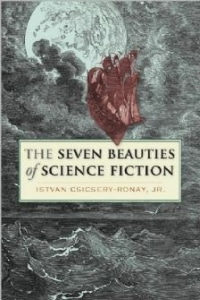The Seven Beauties Of Science Fiction by Istvan Csicsery-Ronay, Jr. (book review).
I think the title ‘The Seven Beauties Of Science Fiction’ is something of a misnomer. Author Istvan Csicsery-Ronay, Jr. uses the ‘Beauty’ label as a descriptive for various aspects of Science Fiction, not as a selection choice for pretty characters or actors who’ve been significant in SF. As such, he introduces you to a variety of subjects and pointing out their significant use by SF authors. Had I read this book as a youngster, I would be making copious notes as to which books I should read. Now I find I’ve read and even reviewed some of them here so if you want to gain an education in Science Fiction than this will serve you well.
It’s rather interesting where Csicsery-Ronay points out that HG Wells saw using scientific jargon as a replacement for magic words than work out from a scientific approach. More so, because what was the magic word for germs? In some respects, this is very telling in that the stories remain the same, just the approach that is different.
Csicsery-Ronay spends a chapter looking at this and how SF authors fudge science a little when it comes to making some propositions that we can’t do right now possible. I agree it’s invariably a grey area but without fudging, a lot of SF scenarios would be out the window and we’d all be writing Hard Science Fiction. However, some things like cloning and cyborgs which are now possible has had its ethical examination in SF long before they became possible and we are better prepared for them. If faster-than-light travel, by whatever means, became possible then at least we are aware of secondary considerations and hope we don’t run into any space wars out there. Nevertheless, I see chapter four as required reading for all SF authors.
With chapter five, Csicsery-Ronay’s discussion about ‘2001: A Space Odyssey’ is quite illuminating. When Kubrick directed the film, the position of women in society wasn’t, shall we say, quite as well observed as we have today. I suspect the real Discovery didn’t have any female hibernauts was not to leave open any suggestion of hanky-panky on wakening. Considering that in ‘The Lost Worlds Of 2001’, its author, Arthur C. Clarke, did present Kubrick with a scenario of zero-gravity sex, I suspect the director felt it might seem a distraction, let alone there was not a need to show the hibernauts lives before the Jupiter Mission. I’ve always seem the StarChild fetal look as more a need to show Bowman was still evolving in his second stage.
The discussion on the ‘Alien’ film franchise is even more extensive, especially on the focus on the female protagonist. Considering that Ripley was originally going to be a male character, would a ‘he’ have been as iconic or is it down to Sigourney Weaver’s acting skill? I liked Csicsery-Ronay’s observation that we see less damage to the artificial person’s bodies over the films. Then again, had Call been ripped apart in ‘Resurrection’, then there would have been two characters that would have needed to be carried about.
Csicsery-Ronay’s views on space opera mirrors my own in how much it shares aspects many aspects of other genres. Mind you, I would go further and say that this applies to other sub-genres as well. If anything, the general genres are probably purer than Science Fiction.
In the seventh chapter, Csicsery-Ronay’s examination of the various types of characters is another must read chapter. His views on the ‘Handy Man’ or problem-solver who can repair anything is an interesting observation because we see it so much that we never question how they acquired such skills. I mean, if you’re that much of an adventurer, just how would you sit down in class and learn so much without blundering? A lot of the time, I think that this is just a matter of combining characters to keep the numbers down.
Things I learnt. I loved the reminder of how the moons of the outer planets are named. Neptune’s from gods and nymphs of Roman and Greek mythologies, Saturn’s from the Titans and Jupiter from Zeus/Jupiter’s lovers. The odd one is Uranus where all but one is named after Shakesperian characters. The Klingon language was sourced from the Native American languages. Makes you wonder what they thought of that.
Although Csicsery-Ronay wrote this book like a thesis, this shouldn’t put you off because if you let the words flow then you’ll pick up the meaning that he is driving at. As pointed out above, a couple chapters are definitely required reading. I should point out that the actual text ends at page 266, the remaining 60 pages are accounted for by footnote references and the index. He covers a lot of ground and understands our subject, looking at books and films under an equal light. It’s worth a think.
GF Willmetts
January 2014
(pub: Wesleyan University Press. 323 page indexed small enlarged paperback. Price: £24.50 (UK), $27.95 (US). ISBN: 978-0-8195-7092-5)
check out websites: www.wesleyan.edu/wespress and www.eurospanbookstore.com

